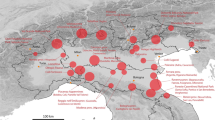Abstract
The relationship between the conservation of plant genetic resources and their culture history is intimate. Consequently, biodiversity research must also take into account historical and cultural factors. An inventory of plants collected from all over Sweden was made with the aim of establishing a national Swedish gene bank for once cultivated hop. Only female hop, which could be regarded as cultivated hop on the basis of history, were selected. In this study, two different inventory methods were used: one based on plant habitat and the other involving the use of historical documents, primarily large-scale maps from the first half of the seventeenth century, used to locate their cultivars today. The documented history of the hop, combined with its biology, is the basis for the methods used. Hop is the only Swedish crop that according to a 1442 law had to be cultivated. The law lasted for over 400 years. Since the hop is a perennial, dioecious plant and only female individuals are cultivated, over time very few genetic recombination events are expected. Today, it is possible to connect and identify living plants using historical documents. The degree of connection between today’s living plants and the historical evidence for hop cultivation differ between the two methods.





Similar content being viewed by others
References
Barth HJ, Klinke C, Schmidt C (1994) The hop atlas. The history and geography of the cultivated plant. John Barth & Sohn, Nürnberg
Beatesson RA (2005) Genetic analysis of agronomic and chemical characters in hop (Humulus lupulus L.). ISHS Acta Hort (ISHR) 668:53–58
Behre KE (1999) The history of beer additives in Europe—a review. Veget Hist Archaeobot 8:35–48
Biendl M, Prinzl C (2007) Arzneipflanze Hopfen; Anwendung—Wirkung—Geschichte. Deutsches Hopfenmuseum Wolnzach, München
Bromelio O (1770) Lupulogia., 3e upplagan. Lars Salvii, Stockholm
Fogelberg P (1760) Kort underrättelse om humleplantering till lantmännens tienst uti Skaraborgs Län, Skara
Hammer K, Knüpffer H, Perrino P (1990) A checklist of the south Italian cultivated plants. Kulturpflanze 38:191–310
Hansson A-M (1996) Finds of hops, Humulus lupulus L., in the black earth of Birka, Sweden. Esbjerg Museum, Arkeologiske Rapporter 1:129–137
Henning JA, Steiner JJ, Hummer KE (2004) Genetic diversity among world hop accessions grown in the USA. Crop Sci 44:411–417
Holmbäck Å, Wessén E (1933) Svenska landskapslagar tolkade och förklarade för nutidens svenskar. Första serien. Östgötalagen och Upplandslagen. Gebers, Stockholm
Holmbäck Å, Wessén E (1962) Magnus Erikssons landslag i nusvensk tolkning. AB Nordiska bokhandeln, Stockholm
Holmbäck Å, Wessén E (1966) Magnus Ericssons stadslag. AB Nordiska bokhandeln, Stockholm
Hummer KE (2005) Wild humulus genetic resources at the U.S. national clonal germplasm repository. Acta Hort (ISHS) 668:75–80
Hybel N, Poulsen B (2007) The danish resources c. 1000–1550. Leiden and Boston, Brill, pp 213–214
Javornic B, Jakše J, Štajner N, Kozjak P, Čerenak A (2005) Molecular genetic hop (Humulus lupulus L.) research in Slovenia. Acta Hort (ISHS) 668:31–34
Lagerås P (2003) Aristokratin i landskapet. Paleoekologiska studier i Järrestads järnålder. Riksantikvarieämbetet, Arkeologiska undersökningar, Stockholm 51, pp 243–270
Nesvadba V, Kofta K (2005) Genetic sources of hops in Czech Republic. I.H.G.C. George, South African, pp 25–26
Nesvadba V, Krofta K, Patzak J (2007) Variability of wild hops (Humulus lupulus L.) in Czech Republic. I.H.G.C. Hüll, Germany, p 32
Neumanns J (1759) Wirtschaftliche und rechtliche Abhandlung von dem Hopfen. Nürnberg
Schroeder F-G (1969) Zur Klassifizierung der Anthropochoren. Vegetatio 16:225–238
Seefelder S, Ehrmeier H, Schweizer G, Seigner E (2000) Genetic diversity and phylogenetic relationship among accessions in hop (Humulus lupulus L.). Plant Breeding 119:257–263
Shephard HL, Parker JS, Darby P, Ainsworth CC (2000) Sexual development and sex chromosomes in hop. New Phytol 148:379–411
Silfverstolpe Carl (1897) Vadstena klosters jordebok 1500, jämte tillägg ur klostrets äldre jordeböcker. Historiska handlingar XVI:I, P.A. Nordstedt & Söner, Stockholm
Suominen J (1990) How far to the north does Humulus lupulus occur as a spontaneous plant in Sweden? Svensk Bot Tidskr 84:259–265
von Linné C (1811) Lachesis lapponica (published from the original manuscript journal by E Smith). London
Swedish archives
Collections of 17th century large-scale maps. A2, A3, Nya Bergkvara, P2, Öresten. “National edition of the oldest geometrical maps”. National Archives
Sandbergska samlingen HH 205–206. National Archives
Acknowledgments
This work was funded by Formas, the Swedish Research Council for Environment, Agricultural Sciences and Spatial Planning and the Royal Swedish Academy of Agriculture and Forestry. The large-scale maps are scanned by the project “National edition of the oldest geometrical maps” at National Archives, financed by The Royal Academy of Letters and The Bank of Sweden Tercentenary Foundation.
Author information
Authors and Affiliations
Corresponding author
Rights and permissions
About this article
Cite this article
Strese, EM.K., Karsvall, O. & Tollin, C. Inventory methods for finding historically cultivated hop (Humulus lupulus L.) in Sweden. Genet Resour Crop Evol 57, 219–227 (2010). https://doi.org/10.1007/s10722-009-9464-9
Received:
Accepted:
Published:
Issue Date:
DOI: https://doi.org/10.1007/s10722-009-9464-9




